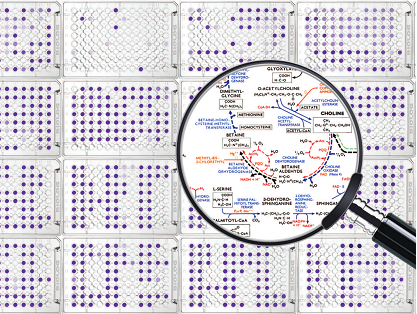Solutions
솔루션
Phenotype MicroArray™
한번의 실험으로 수백여 개의 세포적 피노타입(Cellular Phenotypes) 정성/정량 분석 home
home- > 솔루션 >
- Phenotype MicroArray™
|
[Cell phenotyping] 마이크로바이옴
인성크로마텍(주)
|
| Date : 2019.11.26 |
| 분류 : 미생물세포 |
Research into Human, Animal, Plant, and Environmental Microbiomes has exploded recently and new tools are being developed to study these communities, the types of microbes present,as well as the dynamics (stability or variability) of the communities. While metagenomic studies have revealed immense diversity, additional tools are required to understand the community structure, function, and their interaction with host environments.
Biolog has unique solutions and choices for metabolic profiling of bacterial communities, as well as individual strains of interest, including those that are anaerobic or microaerophilic.
Microbiome Analysis Using Phenotypic Profiling
• Provides a different perspective on microbiomes based on metabolism which may predict the phenotypic behavior better than metagenomic sequencing • Detects changes in the relative metabolic rates of various substrates (polysaccharides, sugars, proteins, amino acids, carboxylic acids, fatty acids) • Detects changes in the relative sensitivity to anti-bacterials and other toxic compounds • May be used to examine other important aspects of microbial communities such as toxin production • Is easy to perform in 96 well plates pre-coated with metabolic substrates or inhibitory chemicals
1. ANAEROBIC COMMUNITY ANALYSIS
Option #1: AN (Anaerobic) MicroPlates:
• A 96 well plate containing 95 carbon sources specifically selected for anaerobic bacteria using a colorimetric redox dye. • Plates can be read in the OmniLog instrument which provides important advantages for throughput, kinetics, and accessing Biolog data analysis software. Plates can also be read on the MicroStation or other microplate readers
• Results are obtained in 24 hours or less, usually within 8 hours
Option #2: Phenotype MicroArray MicroPlates: • Collection of 20 defined plates representing 1920 phenotypic tests to investigate aspects of cellular metabolism, as well as sensitivity to a broad range of microbial inhibitors • In this method, these assays are growth-based and use turbidity rather than dye formation. Assays take typically 2 to 4 days depending on the specific anaerobe and their growth rate • The plates can be read in a microplate reader (OD-750) to measure cell density in the wells
For a listing of chemicals in Phenotype MicroArrays MicroPlates 1-10 (metabolic panels) click here. For a listing of chemicals and antimicrobials in Phenotype MicroArrays MicroPlates 11-20 (chemical sensitivity panels) click here.
(Both of the above options require the use of an anaerobic chamber for inoculating the MicroPlates)
2. AEROBIC COMMUNITY ANALYSIS
Option #1: EcoPlates Used by Microbial Ecologists for more than 25 years to assess the diversity of microbial communities. The EcoPlate contains 31 different carbon sources, repeated 3 times.The plate can be used for 3 different samples – or 1 sample in triplicate.
Option #2: GEN III MicroPlate Used for identification of more than 1,500 aerobic bacterial species. It contains 71 carbon source and 23 chemical sensitivity tests chosen to optimally differentiate aerobic bacteria.It can also be used to assess microbial community function.
Option #3: Phenotype MicroArray Plates • Collection of 20 defined plates representing 1920 phenotypic tests to investigate aspects of cellular metabolism, as well as sensitivity to a broad range of microbial inhibitors. In addition to profiling carbon metabolism, these plates also offer the option to profile nitrogen, phosphorus, and sulfur metabolism.
• When used with the appropriate redox dye, optimal results are achieved using an OmniLog (incubator, automation, reader) and associated software
For a listing of chemicals in Phenotype MicroArrays MicroPlates 1-10 (metabolic panels) click here. For a listing of chemicals and antimicrobials in Phenotype MicroArrays MicroPlates 11-20 (chemical sensitivity panels) click here.
3. SINGLE STRAIN IDENTIFICATION AND METABOLIC ANALYSIS
Multiple different plates can be used for species level identification of aerobes, anaerobes, yeast and filamentous fungi. In addition, all of these organisms can be used with the Phenotype MicroArray Plates to provide a full analysis of the cells’ metabolic and chemical and sensitivity phenotypes.
Plate options include:
FF MicroPlate (Filamentous Fungi) Phenotype MicroArray Plates (Detailed Phenotypic Characterization)
Gut Microbiome - New Approaches to Analysis from Biolog on Vimeo.
|



